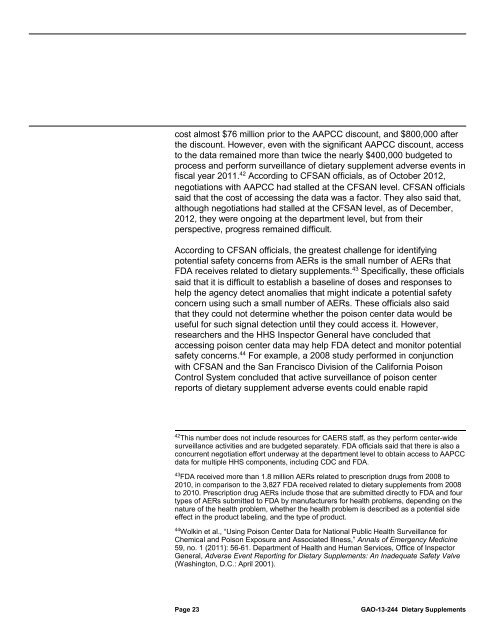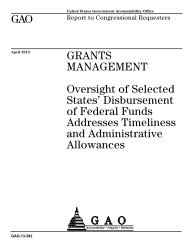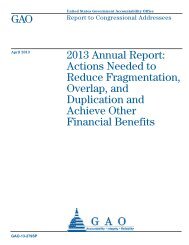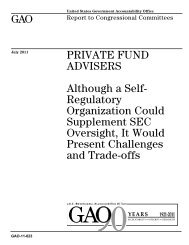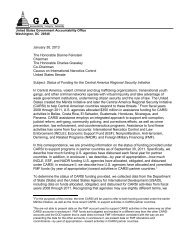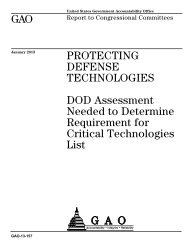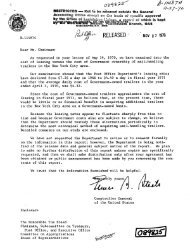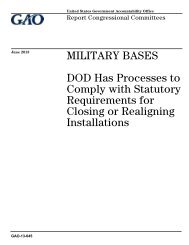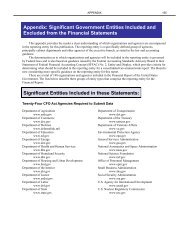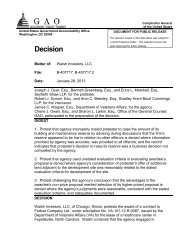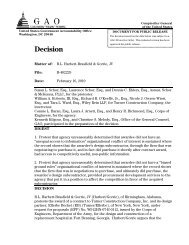Dietary supplements: FDA may have opportunities to expand its use
Dietary supplements: FDA may have opportunities to expand its use
Dietary supplements: FDA may have opportunities to expand its use
You also want an ePaper? Increase the reach of your titles
YUMPU automatically turns print PDFs into web optimized ePapers that Google loves.
cost almost $76 million prior <strong>to</strong> the AAPCC discount, and $800,000 after<br />
the discount. However, even with the significant AAPCC discount, access<br />
<strong>to</strong> the data remained more than twice the nearly $400,000 budgeted <strong>to</strong><br />
process and perform surveillance of dietary supplement adverse events in<br />
fiscal year 2011. 42 According <strong>to</strong> CFSAN officials, as of Oc<strong>to</strong>ber 2012,<br />
negotiations with AAPCC had stalled at the CFSAN level. CFSAN officials<br />
said that the cost of accessing the data was a fac<strong>to</strong>r. They also said that,<br />
although negotiations had stalled at the CFSAN level, as of December,<br />
2012, they were ongoing at the department level, but from their<br />
perspective, progress remained difficult.<br />
According <strong>to</strong> CFSAN officials, the greatest challenge for identifying<br />
potential safety concerns from AERs is the small number of AERs that<br />
<strong>FDA</strong> receives related <strong>to</strong> dietary <strong>supplements</strong>. 43 Specifically, these officials<br />
said that it is difficult <strong>to</strong> establish a baseline of doses and responses <strong>to</strong><br />
help the agency detect anomalies that might indicate a potential safety<br />
concern using such a small number of AERs. These officials also said<br />
that they could not determine whether the poison center data would be<br />
<strong>use</strong>ful for such signal detection until they could access it. However,<br />
researchers and the HHS Inspec<strong>to</strong>r General <strong>have</strong> concluded that<br />
accessing poison center data <strong>may</strong> help <strong>FDA</strong> detect and moni<strong>to</strong>r potential<br />
safety concerns. 44 For example, a 2008 study performed in conjunction<br />
with CFSAN and the San Francisco Division of the California Poison<br />
Control System concluded that active surveillance of poison center<br />
reports of dietary supplement adverse events could enable rapid<br />
42 This number does not include resources for CAERS staff, as they perform center-wide<br />
surveillance activities and are budgeted separately. <strong>FDA</strong> officials said that there is also a<br />
concurrent negotiation effort underway at the department level <strong>to</strong> obtain access <strong>to</strong> AAPCC<br />
data for multiple HHS components, including CDC and <strong>FDA</strong>.<br />
43 <strong>FDA</strong> received more than 1.8 million AERs related <strong>to</strong> prescription drugs from 2008 <strong>to</strong><br />
2010, in comparison <strong>to</strong> the 3,827 <strong>FDA</strong> received related <strong>to</strong> dietary <strong>supplements</strong> from 2008<br />
<strong>to</strong> 2010. Prescription drug AERs include those that are submitted directly <strong>to</strong> <strong>FDA</strong> and four<br />
types of AERs submitted <strong>to</strong> <strong>FDA</strong> by manufacturers for health problems, depending on the<br />
nature of the health problem, whether the health problem is described as a potential side<br />
effect in the product labeling, and the type of product.<br />
44 Wolkin et al., “Using Poison Center Data for National Public Health Surveillance for<br />
Chemical and Poison Exposure and Associated Illness,” Annals of Emergency Medicine<br />
59, no. 1 (2011): 56-61. Department of Health and Human Services, Office of Inspec<strong>to</strong>r<br />
General, Adverse Event Reporting for <strong>Dietary</strong> Supplements: An Inadequate Safety Valve<br />
(Washing<strong>to</strong>n, D.C.: April 2001).<br />
Page 23<br />
GAO-13-244 <strong>Dietary</strong> Supplements


